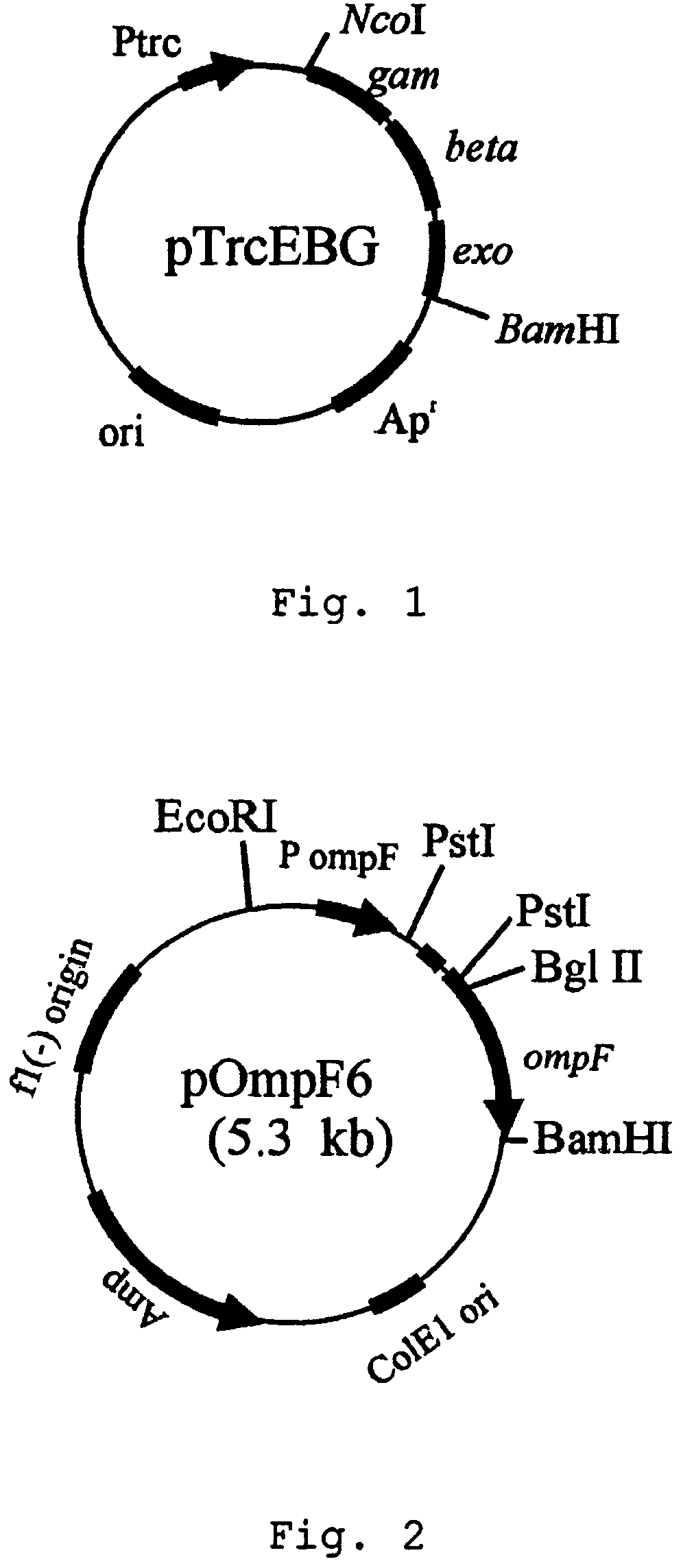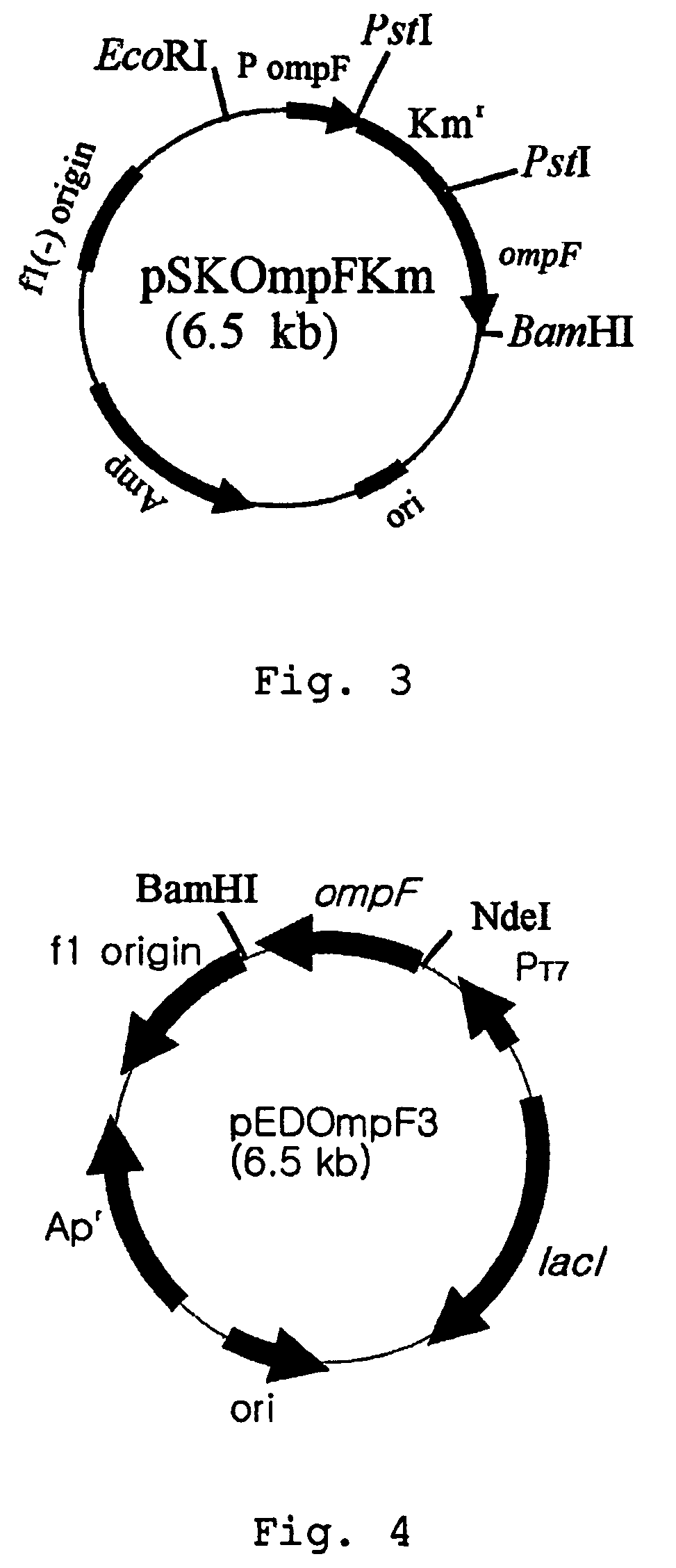Method for extracellular production of target proteins employing OmpF in E. coli
a technology of target proteins and e. coli, which is applied in the direction of peptides, enzymology, dna/rna fragmentation, etc., can solve the problems of inability to achieve high concentration cell culture strains
- Summary
- Abstract
- Description
- Claims
- Application Information
AI Technical Summary
Benefits of technology
Problems solved by technology
Method used
Image
Examples
example 1
Selection of E. coli Strain Over Expressing OmpF
[0025]Six E. coli strains conventionally used for the production of recombinant proteins were selected, and outer membrane proteins were purified therefrom and compared with one another by carrying out SDS-PAGE. Six E. coli strains thus selected were E. coli BL21(DE3)[F-ompT hsdSB(rB-mB-) gal dcm(DE3) a prophage carrying the T7 RNA polymerase gene](Novagen Co., U.S.A.), HB101[F-hsd20(rk-, mk-) recA13 ara-14 proA2 lacY1 galK2 rpsL20(str) xyl1-5 mtl-1 supE44 λ-](New England Biolabs, U.S.A.), JM101[supE thii-1 Δ(lac-proAB) [F′traD36 proAB lacIqZ ΔM15]](Stratagene Co., U.S.A.), MC4100[F-araD139 Δ(argF-lac)U169 rpsL150(strr) relA1 flbB5301 deoC1 ptsF25 rbsR](Stratagene Co., U.S.A.), XL1-Blue[SupE44 hsdR17 recA1 endA1 gyrA96 thi relA1 lacF(proAB+lacIq lacZM15 Tn10(tetr)](Stratagene Co., U.S.A.), and W3110[derived from K-12, λ-, F—, prototrophic](KCTC 2223). Each of E. coli strains was cultured in 50 mL of LB media(tryptone 10 g / L, yeast extr...
example 2
Preparation of E. coli Strain Lacking an OmpF Gene
[0028]ompF gene of E. coli BL21(DE3) was deleted by using red operon(exo-beta-gam) of bacteriophage: First, PCR was performed by employing bacteriophage DNA as a template and primer pair of primer 1: 5′-CGCGCCATGGATATTAATACTGAAACTGAGATCAAGC-3′(SEQ ID NO. 1) and primer 2: 5′-CGGGATCCTCATCGCCATTGCTCCCCAAATAC-3′(SEQ ID NO. 2). The amplified PCR product was separated on 1.2% agarose gel by electrophoresis to obtain 2.2 kb DNA fragment. The DNA fragment was digested with NcoI and BamHI restriction enzymes. The expression plasmid pTrc99A(Pharmacia Biotech Co., U.S.A.) containing trc promoter was also digested with NcoI and BamHI restriction enzymes, and ligated to the PCR product digested with the same restriction enzymes to construct a recombinant expression vector pTrcEBG. Then, E. coli XL1-Blue strain was transformed with the expression vector pTrcEBG and transformants were screened on LB plate containing 50 μg / L ampicillin(see: FIG. 1)...
example 3
Development of Expression System of ompF Gene
[0030]In order to express OmpF protein in E. coli BL101 recombinant strain prepared in Example 2, three recombinant expression vectors were constructed, respectively.
[0031]First, an expression vector of ompF gene was constructed employing T7 promoter that is a strong inducible expression promoter. PCR was performed using genomic DNA of E. coli BL21(DE3) as a template and primer 4 and primer 10: 5′-GCGAATTCATATGATGAAGCGCAATATTCTG-3′(SEQ ID NO. 10). The amplified PCR product was digested by NdeI and BamHI and cloned into an expression vector pET21c(Novagen, U.S.A.) to construct a recombinant expression vector pEDOmpF3. E. coli XL1-Blue strain was transformed with pEDOmpF3 and the recombinant expression vector pEDOmpF3 was obtained therefrom(see: FIG. 4). FIG. 4 represents a genetic map of recombinant expression vector pEDOmpF3.
[0032]Secondly, an expression vector of ompF gene was constructed employing Trc promoter that is an inducible expre...
PUM
| Property | Measurement | Unit |
|---|---|---|
| pH | aaaaa | aaaaa |
| pH | aaaaa | aaaaa |
| temperature | aaaaa | aaaaa |
Abstract
Description
Claims
Application Information
 Login to View More
Login to View More - R&D Engineer
- R&D Manager
- IP Professional
- Industry Leading Data Capabilities
- Powerful AI technology
- Patent DNA Extraction
Browse by: Latest US Patents, China's latest patents, Technical Efficacy Thesaurus, Application Domain, Technology Topic, Popular Technical Reports.
© 2024 PatSnap. All rights reserved.Legal|Privacy policy|Modern Slavery Act Transparency Statement|Sitemap|About US| Contact US: help@patsnap.com










